Tableturf Battle: Difference between revisions
(Added several level-up rewards) |
m (Extra reward detail) |
||
| Line 140: | Line 140: | ||
| 29 || Rival: '''Frye''' | | 29 || Rival: '''Frye''' | ||
|- | |- | ||
| 30 || Emote and badge | | 30 || Emote (card shark), and badge | ||
|- | |- | ||
| 31 || ??? | | 31 || ??? | ||
Revision as of 17:22, 12 September 2022

Can you help us get it done?
Tableturf Battle is an in-universe collectible card game inspired by Turf War battles, but turn-based and designed for two players. Both players use the cards in their custom decks to add ink patterns to a grid-like board, competing to have the most ink on the board at the end of the game.
Tableturf Battle is popular in the Splatlands and can be played in Splatsville's Tableturf Battle Dojo.
History
Tableturf Battle was announced on 10 August 2022 during the Splatoon 3 Direct. It was released with the launch of Splatoon 3.
Cards
- Main article: List of Tableturf Battle cards in Splatoon 3
As of now, there are 162 cards to collect. The cards are based on weapons, characters, and other Splatoon concepts such as Tower Control.
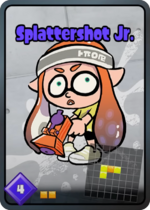
Attributes
The face of every card has:
- a violet, yellow, or multi-colored name at the top,
- an illustration in the center,
- an 8-by-8 square grid containing an ink pattern in the lower-right corner,
- a number inside a violet, yellow, or multi-colored diamond in the lower-left corner, and
- a Special Attack cost, indicated by one to five Special Space squares at the bottom.
The ink pattern depicted in the grid is added to the board when the card is played. There are two varieties of ink, one of which appears in the grid no more than once per card. These less-common ink spaces are called Special Spaces.
The number in the lower-left corner corresponds to the number of ink spaces in the pattern.
There are three levels of card rarity: Common, Rare, and Fresh.
Each card has a sequence number that is not shown on the card but can be used for sorting. For example, the .52 Gal card is No. 7.
Acquiring cards
Every player receives a starter deck from Staff at the Tableturf Battle Dojo.[1]
Players can earn packs of cards by increasing their Tableturf Battle rank[2] or catalog level. The Shell-Out Machine also has a chance to dispense packs.[3] A pack contains five random cards.[2] Players cannot own more than one copy of a card;[2] duplicates are converted to Card-Bits.[2][4] Players can spend Card-Bits to acquire new cards or upgrade the appearance of existing cards.[2]
Decks
A deck contains 15 cards.
A player can save up to 16 decks, assigning a name and a card sleeve design to each one. Two different card sleeve designs have been shown: one bearing only the Tableturf Battle logo, and another featuring a large Ammo Knights logo and a smaller Tableturf Battle logo.
Starter Deck
The starter deck contains the following cards: Splattershot, Blaster, Splat Roller, Splat Charger, Heavy Splatling, Slosher, Splat Dualies, Tri-Stringer, Splatana Wiper, Splat Bomb, Zapfish, Flooder, Chum, SquidForce, and Marigold.
Rules
A game lasts 12 turns. Each turn, working simultaneously, both players choose a card from a hand of four cards and decide where to place that card's ink pattern on the board. Players may also pass, discarding one card from their hand and gaining a Special Point.
Ink placement
A card's ink pattern must be placed orthogonally or diagonally adjacent to spaces that already contain the player's ink. On a normal turn, it cannot overlap existing ink.
If both players try to place their ink patterns in the same spot, one of two things happens:
- If the two cards have different numbers, then the card with the larger ink pattern is placed first, and the card with the smaller ink pattern is placed second. The smaller pattern covers up the larger one.[5][6] However, normal ink spaces do not cover Special Spaces.
- If the two cards have the same number, then both cards add their ink patterns to the board at the same time. Spaces where the patterns overlap become neutral walls and cannot be inked again.
Special Spaces and Special Attacks
If one of a player's Special Spaces on the board becomes surrounded by the ink of either color and/or walls, that player earns a Special Point.
A player can spend Special Points to play a card as a Special Attack, allowing the card's ink pattern to replace existing ink (but not Special Spaces). When a card is played as a Special Attack, its ink pattern must be placed orthogonally or diagonally adjacent to one of the player's own Special Spaces on the board.
End of game
The player with the most ink spaces on the board at the end of the game wins.
Rank and rewards
Players earn Tableturf Points at the end of each game. 40 points are awarded for a loss or draw, while 100, 115, or 130 points are awarded for a win against a Splatsville rival, depending on the rival's level.
At certain point thresholds, the player's Tableturf Rank increases, allowing access to new opponents and unlocking new Tableturf Battle stages (for use when testing out decks in the editor), as well as Splashtag and Emote options.[2]
| Rank | Reward |
|---|---|
| 1 | N/A |
| 2 | Rival: Cool Jelly |
| 3 | Pack of cards |
| 4 | Rival: Aggro Jelly |
| 5 | Stage: Thunder Point |
| 6 | Title: Fun - Tableturf Battler |
| 7 | Rival: Sheldon |
| 8 | Stage: X Marks the Garden |
| 9 | Pack of cards |
| 10 | Banner |
| 11 | Rival: Gnarly Eddy |
| 12 | Locker sticker |
| 13 | Rival: Jel La Fleur |
| 14 | Stage: Square Squared |
| 15 | Rival: Mr. Coco |
| 16 | Pack of cards |
| 17 | Rival: Harmony |
| 18 | Stage: Lakefront Property |
| 19 | Rival: Judd |
| 20 | Card sleeve |
| 21 | Rival: Li'l Judd |
| 22 | Stage: Double Gemini |
| 23 | Pack of cards |
| 24 | Rival: Murch |
| 25 | Banner (TableTurf Tiles) |
| 26 | Rival: Shiver |
| 27 | Stage: River Drift |
| 28 | Locker decoration |
| 29 | Rival: Frye |
| 30 | Emote (card shark), and badge |
| 31 | ??? |
| 32 | ??? |
| 33 | ??? |
| 34 | ??? |
| 35 | ??? |
Opponents
Players can battle their way to the top by challenging the 'Splatsville locals', a group of computer controller Battleturf opponents. The 'Splatsville locals' are comprised of "Baby Jelly", "Cool Jelly", "Aggro Jelly", "Sheldon", "Gnarly Eddy", "Jel La Fleur", "Mr. Coco", "Harmony", "Judd", ...
Each of the 'Splatsville locals' have 3 difficulty rankings (Rank 1, Rank 2, and Rank 3). When a new 'Splatsville local' is unlocked, only Rank 1 is available for the player to challenge. When the player has beaten a 'Splatsville local' three times at a particular Rank, the next sequential Rank is unlocked.
A free update to Splatoon 3 will allow online play against other human players.[7]
Stages
There are eight stages:
| Icon | Name | Spaces |
|---|---|---|
 |
Box Seats | 100 |
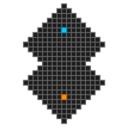 |
Double Gemini | 249 |
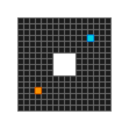 |
Lakefront Property | 240 |
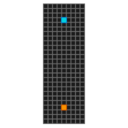 |
Main Street | 234 |
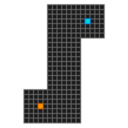 |
River Drift | 245 |
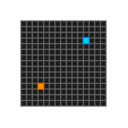 |
Square Squared | 225 |
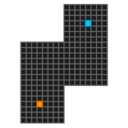 |
Thunder Point | 240 |
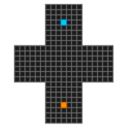 |
X Marks the Garden | 245 |
Quotes
| “ | Remember the discovery of the Tableturf Battle minigame in our Splatoon 3 Direct? SRL here - we wanted to make sure this competitive card game didn't get lost in the shuffle, so to speak. Collect cards, build out your deck, and see who can ink the most 2D table turf to win!
Of course, Tableturf Battle is deeper than that, and we've discovered that an official manual exists! Nothing beats field research, but you can get a tentacle up by reading through the manual carefully before starting a battle. Did you even KNOW there are Special Attacks? |
” |
Trivia
- Some cards have similar postures to weapon illustrations and promotional materials.
Gallery
-
Tableturf Battle card sleeve
-
Tableturf Battle card sleeve
-
Card List screen[10]
-
Results screen [10]
-
Tableturf Battle machines on the upper floor of the Battle Lobby.
-
Card illustrations
-
Card illustrations
Rules
-
Tableturf Battle: The Freshest Card Game
-
A One-on-One Turf War...with Cards!
-
Ink It All with Cards
-
The Rules of Inking
-
The Where and How of Inking
-
Special Points for You
-
Special Attacks Turn the Tide
-
Build Your Collection
-
Deck Out Your Cards
Names in other languages
Translation notes
References
- ↑
 Splatoon 3: Squid Research Lab Confidential Report (JP)
Splatoon 3: Squid Research Lab Confidential Report (JP)
- ↑ 2.0 2.1 2.2 2.3 2.4 2.5 Tableturf Battle - Famitsu.com
- ↑ File:Tableturf Battle Intro 8.jpg
- ↑ File:Tableturf Battle Intro 9.jpg
- ↑
 Splatoon 3 TableTurf Battle mode! @2:54
Splatoon 3 TableTurf Battle mode! @2:54
- ↑
 Splatoon 3 TableTurf Battle mode! @4:48
Splatoon 3 TableTurf Battle mode! @4:48
- ↑ Cite error: Invalid
<ref>tag; no text was provided for refs namedgamexplain_online_later - ↑
 @SplatoonNA on Twitter
@SplatoonNA on Twitter
- ↑
 @SplatoonNA on Twitter
@SplatoonNA on Twitter
- ↑ 10.0 10.1
 Splatoon 3 Direct summary - Nintendo of Korea
Splatoon 3 Direct summary - Nintendo of Korea
|
![Card List screen[10]](http://cdn.wikimg.net/en/splatoonwiki/images/thumb/d/de/Tableturf_Battle_Card_List.jpg/120px-Tableturf_Battle_Card_List.jpg)
![Results screen [10]](http://cdn.wikimg.net/en/splatoonwiki/images/thumb/f/f6/Tableturf_Battle_Results.jpg/120px-Tableturf_Battle_Results.jpg)










